|
|
|
CONTACT US
Click Here! |
| This site is best viewed with a screen resolution of 800 X 600 at high colour settings |
|
Flask list
Acacallis-Ancistrochilus Angraecum-Aspasia Barkeria-Broughtonia Bulbophyllum Capanemia-Catasetum Cattleya Cattleyopsis-Cycnoch, Cymbidium-Cyrtorchis Dendrobium-Dossinia Encyclia-Eulophiella Galeandra-Kalopternix Laelia-Lycaste Macodes-Nephalaphyll, Odontogloss,-Oncidium Paphiopedilum-Psychilis Rangaeris-Stenocoryne Tainia-Zygopetalum |
|
Plant list
Acampe-Bulbophyllum Cattleya-Dossinia Encyclia-Promeaea Renanthera-Vanda |

WHATS
NEW ?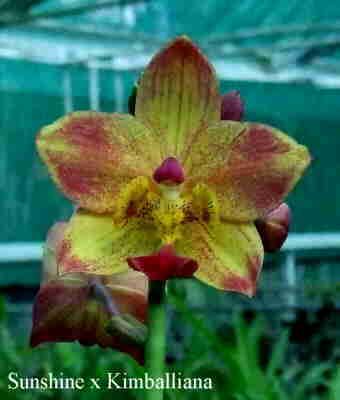
In FLASK. Cattleya nobilior Cattleyopsis ortgiesiana Dendrobium sladei Encyclia mareae. Mormodes buccinator Spathoglottis (Sunshine x Kimballiana) x sulawesiense
In PLANTS. Due to continuing potting we suggest that you send your want list by email to ianbpon(at)speciesorchids.com
Please substitute @ for (at) to avoid Spam. A reply by email will advise current stocks of plants of interest. Some species are listed below.
Featuring two giants; Bulbophyllum fletcherianum and Grammatophyllum wallisii
Ready to replate.Acacallis
cyanea, Anoectochilus
brevilabris, Bletia florida, Catasetum sanguineum, Cattleya
guttata alba x alba, Cattleya guttata alba "Munda Yellow",
Coryanthes gernotii "Gernots Special ", Cymbidium eburneum,
Dendrobium friedricksianum occulatum, Peristeria elata,
Stanhopea martiana.
Culture. In responce to requests
SOWING ORCHID SEED is
reprinted from a previous Newsletter. Asceptic and natural sowing methods.
International payments. Paypal, Western Union, Bank EFT.
CITES. Flasks exempt.
Seed. Email now for a list of available species orchid seed.
Cloud Forest Institute. Join Conservation of cloud forest.
http://www.speciesorchids.com Web Site. Full descriptions of species flasks and plants plus photographs. Details on ordering, shipping and cultural notes.Links to other interesting sites. Articles on culture, habitat and notes about orchids.
Humour. Have a laugh on us and Keep Smiling.
Highlighted species or subjects are links to photos/articles.
Just click on the subject. Items in this Newsletter may be reproduced provided source acknowledged. Do you know any orchid growers who may like to receive this newsletter? Why not forward this email to them now!
Recent germinations.
Cattleya nobilior.
Intermediate Brazil. Stout bulb,
fls to 13cm, flat, glistening pink purple, lip cream. Does well on a slab or
well drained basket.
Cattleyopsis ortgiesiana
Intermediate to warm. Cuba Rare. Smaller
grower, large brilliant rose-magenta to pale rose fls to 5cm. Rare. Culture as
for Broughtonia, a slab or small well drained pot. "The orchid Castro does not
want you to have" to quote the USA source. Dendrobium sladei.
New Guinea Grastidium, Large cream tinged green flowers. Fragrant.
Named after Herman Slade. Easily grown in a basket or on a slab. An attractive
ever green plant as well. 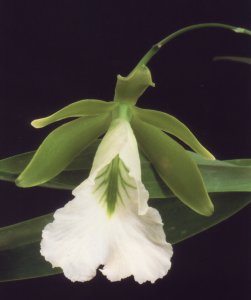
Mormodes buccinator I.W. Central America. Large cream yellow to gold brown, twisted lip, Goblin Orchid. The colours of Mormodes can vary immensely. Deciduous in winter, keep almost dry and repot with new lead. Use a rich semi terrestrial media and lots of fertiliser when in active growth. Photo of Mormodes claeseana shows the remarkable flowers of the Goblin orchids.
The genus has a name as being difficult to keep going, but the dry rest when dormant is essential and perhaps the reputation is due to the lack of the dormant rest.
Spathoglottis (Sunshine x Kimballiana) x sulawesiense. Yellow & orange X robust white. Terrestrial, easy grower. Sunshine is Spath affinis type x plicata, with huge colour variations, so this 3rd generation hybrid may produce a multiple range of colours.
.Top New in Plants
August 2012 Bargain Buys for specimen plants available.
July 2012 Bargain Buys for specimen plants still available.
Below we
feature two giants of the orchid species world.
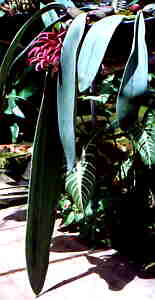
The flowers are individually about 10 to 12 cms long (4 to 5 inch), and are borne in a short many flowered cluster. The flowers are highly scented, somewhat unpleasently so, and it is common to find flies visiting. Its reputation as a dead horse is much exaggerated.
It seems to flower sporadically, not annually, and is slow growing.
Grammatophyllums wallisii (speciosum var wallisii)
Philippines.These
are large growing plants that produce canes up to 5 feet or more long, ( in the
wild, even larger), the old canes yellow and almost pendulous.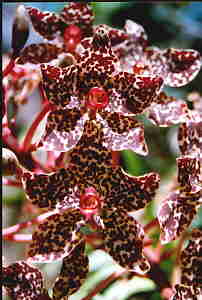
The plants require a large container or basket, will grow in almost full sun or in warmer climes under garden trees or in the fork of a tree provided extra growing media is placed at the roots until the root saucer forms.
These are plants of the wet tropics, where warmth, moisture and sunlight combine to produces these giants of the orchid world.
Top Ready to Replate.
Acacallis cyanea. Intermediate to Warm. Brazil. Fabulous Blue cupped flowers to 6cm, lip indigo blue, allied to Zygopetalum. In Brazil cultivated on a slab of Dicksonia Antarctica, the soft brown treefern that also comes from Tasmania.
Anoectochilus brevilabris I.C. India Jewel orchid.Exquisite, dark green leaf flushed gold, veined silver and gold. Grows in leafmould, well shaded. Photo of the Australian Anoectochilus yateseae in situ.
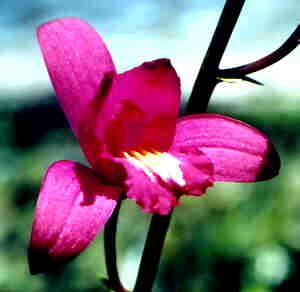
Catasetum sanguineum I.W. Venezuela. Green yellow with much red spots/blotchs. Much like catasetum oerstedii, but more coloured. Rare. A Trigger Orchid, so called for the two triggers inside the labellum, which when touched by the pollinator, ejects the pollen quite forceably onto the back of the pollinator. The pollinator is then off to the next flower.
Cattleya guttata alba x alba. I.W. Brazil. Select USA sib cross 2 different clones, guttata not leopoldii. A robust species, well drained pot or basket with typical cattleya requirements.
Cattleya guttata alba "Munda Yellow" I.W. Brazil. The lutino form, bright yellow, white lip x self.
Coryanthes gernotii Gernots Special I.W. Venezuela. Bucket Orchid. yellow and orange, selected form from Dr Gernot Bergold, Venezuela. Photo of Coryanthes bruckmuellerii shows the fantastic Bucket Orchid. Culture as for Stanhopea, keep just damp at all times, and they benefit from high humdity when in active growth. Basket,pot, semiterrestrial media.
Cymbidium eburneum. I.C.Burma.Flowers to 7.5 cm, pure waxy white, lip with a yellow disc. Typical Cymbidium culture.
Dendrobium friedricksianum occulatum. I.W. Thailand. Softcane, glossy yellow fls, dark eyes on lip. Rest well in winter. Pot Basket.
Peristeria elata. I. W. Panama Dove Orchid. Espiritu Santo.Waxy 5cm white flowers, centre dove like, with some red spotting. A deciduous semi terrestrial, use a rich media, rest in winter, and with new lead, lots of water and fertiliser.
Stanhopea martiana. I. Mexico. Huge flowers, white with red markings. Best grown in a basket so the pendulous spikes can emerge thru the bottom.
Click on species name to view photos
Top Culture.
1 teaspoon Fish Emulsion
11 grams Agar Agar powder
100 grams mashed ripe banana
10 grams sugar
If normal cotton wool is used, use some pharmacy Mercurochrome solution on the cotton wool plug before sterilising.
The seed has to be soaked in a sterilising solution, use a small phial with a lid.
After a determined time, the seed is allowed to settle, the sterilising solution poured off (decanted) and some sterilised water added to the seed and again decanted. This wash can be repeated.
Using the sterile eyedropper, add sterile water to the seed, suck up the seed and add to the flask.
Sterilising solution is a weak chlorine bleach, say 3 to 5%. To determine the time required for sterilising, some experimenting is required.
By setting up a number of phials with seed, a series of timings will determine under sterilisation thru to over sterilising and seed loss.
Start at 3 minutes, then 6, then 9, then 12, then 15.
Germination without contamination at the minimum timing is what is required. If the seed is sterilised but fails to germinate, then it may be over sterilised.
However, once the time is determined between contamination and no contamination, a finer time range can be tried.
So if there is contamination after 3 minutes, but no contaminating after 9 minutes, a range of 4 to 9 minutes can be trialled to establish the optimum sterilising time.
With thanks to Darryl Smedley for the following.
"For some years now I have been using 3 Volume W/V (10%) Hydrogen Peroxide (H2O2) to sterilize orchid seed before sowing. Its simple and easy as its a one-step operation that doesn't require any further washing of the seed as in chlorine-based sterilization procedures.
It works because the Hydrogen Peroxide kills the nasty contaminates then breaks down into water and oxygen after a period.
A friend has suggested that maybe the H2O2 might only work when it decomposes into H2O and O2 and its the nascent oxygen that does the sterilizing - don't know. What I would like to know is how long the process takes to convert from H2O2 to water and oxygen?
There is a practical reason for wanting to know this as I have found that seed sown in the evening generally has a lower germination success rate than seed sown in the morning.
I have speculated that this is because the flasks done at night are under the the lights for only a short period and are in contact with the H2O2 whilst it is still 'active' for several hours until the lights turn on again in the morning.
Flasks done in the morning are under the lights for up to 8 hours before the lights turn off at night.
Presumably the H2O2 breaks down during this period. (I once used 6 Volume H202 by mistake and washed and re-sterilized the seeds within 15 minutes. No good, killed them all stone dead.)
My procedures are that the seed is placed in a test tube and 2.5ml of H2O2 is drawn up and syringed into the tube. The tube is agitated on and off for 5 minutes then the stopper is removed and the liquid and seed poured into the flask.
The flask usually has a small quantity of free water on top of the agar mixture - no more than 0.5 ml. The flask is then placed under 36/37 Watt Growlights at about 18-20" from the tube to the top of the agar.
The flasking room is kept at temperatures ranging from 17-27 deg.C. I'm told that the stabilizer used in H202 is Phosphoric Acid but I don't know in what proportion nor whether its presence contributes to the sterilization in any way".
More photos at www.speciesorchids.com/photos.html
Top Seed
of SPECIES orchids.
Email to ianbpon(at)speciesorchids.com
(Please substitute @ for (at) to avoid Spam) for the latest
list of seed available in packets enough to prepare 3 to 4 flasks. Cattleya, Coryanthes, Dendrobium, Oncidium, Laelia, Aerides with more added as harvested. All seed dated at collection, airmail post world wide and there is no restriction on orchid seed.
CONSERVATION BY PROPAGATION.
Conservation of cloud forest flora and fauna.
Join Cloud Forest Institute THIS IS A VERY IMPORTANT INITIATIVE PLEASE SEE "http://www.cloudforest.org" FOR MORE INFORMATION Join Cloud Forest Institute, a federally recognized 501(c)3 to fund a wildlife corridor in the Ecuadorian Tropical Andes and protect it - forever! The two parcels comprising of 840-acres of Cloud Forest in the Ecuadorian Paso Alto Range of the Andes in the Cambugan Watershed is home to jaguars, spectacled bears, over 300 species of ORCHIDS, and the highest number of endemic amphibian and bird species in the WORLD. Concerned people are encouraged to make tax-deductible donations and create honorary groves in their name.
Flasks are EXEMPT under Convention on International Trade in Endangered Species of Wild Fauna and Flora (CITES), Title 50, Part 23, Subpart C, Appendix II. S 23.23 (d) (6) Specifically exempted: For orchidacea species: (i) in Appendix I, seedling or tissue cultures obtained in vitro, in solid or liquid media, transported in sterile containers.
International payments. Top
Paypal,
Paypal; International transfer of payments by credit card. Log onto "https://www.paypal.com" register, and follow the easy instructions. When making payments by Paypal, remember to add 4% for their transfer fee. Our Paypal address advised when applicable. Important Note; Due to high Bank fees, we recommend the use of Paypal or Western Union (http://www.westernunion.com/index_consumer.asp?country=US) transfers when sending international payments. It is quick and secure.
Electronic Funds Transfer by Bank is also quick and secure, but check Bank fees for the service. Bank details emailed on request. When sending payments internationally, use REGISTERED airmail letters or document envelopes and NOT large packets or padded bags which may be opened by Customs for inspection. Address letters to Ian & Pat Walters, NOT to the Nursery, so there is no indication of contents. NOTE. International MoneyGram is not available for collection here in North Queensland and cannot be accepted.
Top Humour.
Let's go for stupid
A lady was picking through the frozen turkeys at the grocery
store, but couldn't find one big enough for her family. She asked a stock boy,
"Do these turkeys get any bigger?" The stock boy replied, "No
ma'am, they're dead."
Caught for speeding
The cop got out of his car and the kid, that was stopped for speeding, rolled
down his window. "I've been waiting for you all day," the cop said.
The kid replied, "Yeah, well I got here as fast as I could." When the
cop finally stopped laughing, he sent the kid on his way without a ticket.
Stuck under a bridge
A truck driver was driving along on the freeway. A sign comes up that reads
"low bridge ahead." Before he knows it the bridge is right ahead of
him and he gets stuck under the bridge. Cars are backed up for miles. Finally, a
police car comes up. The cop gets out of his car and walks around to the truck
driver, puts his hands on his hips andsays, "Got stuck, huh?" The
truck driver says, "No, I was delivering this bridge and ran out of
gas."
Top Ian and Pat Walters, Burleigh Park Orchid Nursery 54 Hammond Way, Townsville, Australia 4815
Email us at ianbpon(at)speciesorchids.com
(Please situte @ for (at) to avoid Spam)
http://www.speciesorchids.com/
Phone 0747 740 008 International 61 747 740 008
For Web Design and Web Hosting
Contact Orchids Online Web Design